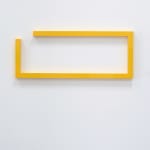


Lori Cozen-Geller American, b. 1952
(45.7 x 114.3 x 6.4 cm)
Further images
Lori Cozen-Geller - living and working in Venice, CA - is an American artist known for her work as a finish fetish minimalist. Unlike the premise of mid-century minimalism where the artwork itself did not hold meaning, Cozen-Geller’s work is based on complex human emotions depicted in ultra-simplistic forms. Born and raised in Los Angeles, California, during the era of minimalism, the bowed and flat roof lines and sleekness of Southern California architecture coupled with the countries obsession with opulent automobiles created the foundation for her artistic style.
“Although my art is an expression of my own personal feelings, these emotions are universal to all of humanity. The energy of life is the fuel that ignites my passion to express.” - Lori Cozen-Geller
Lori Cozen-Geller's notable collections include:
MOAH (Museum of Art and History), Lancaster, CA
Ventura County Museum of History and Art, Ventura, CA
MGM Grand Hotel, Detroit, MI
Classical Progression, Santa Monica, CA
UCLA Medical Center, Los Angeles, CA
Directions Design, Los Angeles, CA
Coldwell Banker, Beverly Hills, CA


